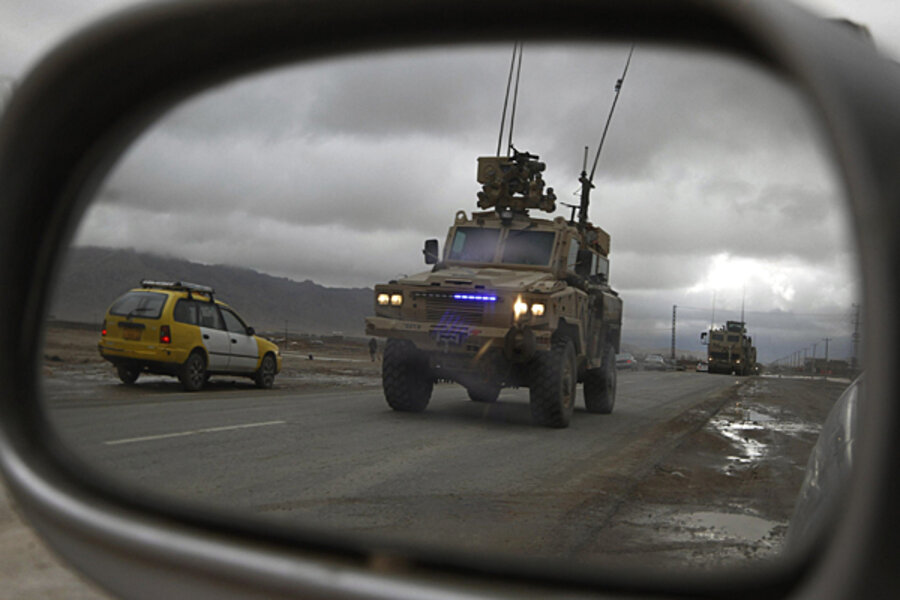Afghanistan war: US troops' new push into 'heart of darkness'
Loading...
| Kandahar, Afghanistan
The soldiers came under Taliban surveillance as soon as they set out. Intercepted radio chatter among insurgents left no doubt that Charlie Company was walking into an ambush as it closed on a Taliban stronghold deep in southern Afghanistan’s Kandahar Province.
The sudden clatter and whine of small-arms and machine-gun fire sent everyone scrambling for cover. Bullets spat up dust from the berms of a grape field. The shots hit far more accurately than those of local fighters – one of many signs that committed militants had returned early from their winter break in Pakistan.
"They were close. That was good stuff," said Spc. Justin Jun, of Lake Tahoe, Calif. "I don't think I'll need to shave in a while."
Since being deployed here six months ago, the United States Army company (1st Battalion, 12th Infantry Regiment) has been pushing due west of the provincial capital, Kandahar, into what foreign forces call the “heart of darkness.” Zhari district – a patchwork of irrigation ditches, grape fields, and tightly packed mud compounds – is not only ideal guerrilla territory but also an area of enormous symbolic importance. Four miles west of Charlie Company’s patrol route lies the village mosque where one-eyed cleric-turned-Taliban leader Mullah Mohammad Omar preached in the 1990s.
Like other infantry battalions fanned out from Kandahar, home to 800,000 people, these soldiers are carrying out Gen. Stanley McChrystal’s strategy of blocking Taliban fighters from civilians whom they hide among and intimidate.
Similar operations are underway across southern Afghanistan as more US troops arrive, with the largest coalition operation of the nine-year war now gearing up in Marjah District in neighboring Helmand Province.
‘Heart of darkness’
In many places, as in Zhari, the battle is just beginning.
Until the deployment of 1st Battalion, 12th Infantry Regiment here, US-led coalition forces in Afghanistan lacked the troops to even challenge the insurgents in the “heart of darkness.”
A single Canadian rifle company had tried to cover the district, while a contingent of 2,500 troops had responsibility for the 20,000 square mile province Kandahar and its million-plus residents. Relative to their number, the Canadians took heavier casualties than any major troop contributor in Afghanistan, accounting to nine percent of the coalition’s 1,626 fatalities despite providing two percent of its current forces.
In Charlie Company's operations area, villagers who can afford to have fled to more peaceful parts of the district, leaving behind the desperately poor and the militants. Commanders and foreign fighters who left at the start of winter have streamed back, including Kaka Abdul Khaliq, a former mujahideen fighter whom the US military holds responsible for the deaths of several servicemen.
"Before he left for Pakistan last year they were conducting all kinds of attacks," says Noel Engels, an American law enforcement official who works with coalition and Afghan units across the district. "It's a big year for [the Taliban]. They need to hold Kandahar as much as possible."
A sharp enemy
The Taliban are sophisticated fighters. Using children as spotters, they have developed an effective early warning system allowing them to plan ambushes and thwart coalition missions targeting their leaders. They exploit the US tendency to counterattack aggressively by drawing the foreign soldiers into traps by planting improvised explosive devices. They have an unsurpassed knowledge of the terrain. They use a command structure under which members of different units – whether IED-making cells or assassination squads – must seek permission before carrying out attacks, allowing greater coordination and instilling a sense of discipline.
Meanwhile the Taliban’s shadow government, led by “district governor” Jebar Agha, organizes gatherings, bans schools, and metes out the brutal but impartial justice that helped raise the original Taliban to power.
There is talk among US officers about the bringing in an entire brigade, but nothing is definite. For the soldiers already in Zhari their work is cut out.
Protracted fight
As the initial confusion of the Jan. 27 attack subsided, Charlie Company began returning fire. Kiowa attack helicopters launched salvoes of missiles, A-10 gunships came in on strafing runs, and F-16 fighter jets growled overhead. In the three-hour attack, only one Afghan man was wounded, shot in the back with a Taliban bullet.
Knowing that the coalition can eavesdrop on their conversations, the Taliban radio operators vowed that reinforcements were on their way. But the insurgents, masters of hit and run, were already slipping away, blending back into the population until the next patrol to come their way.





